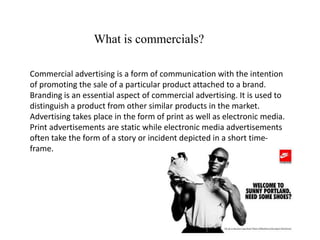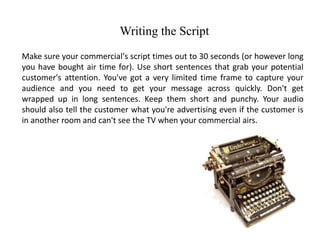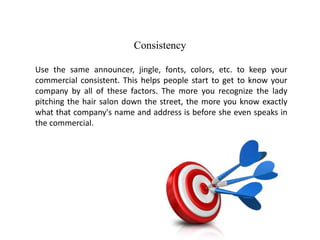Creating Advertisements and Commercials
- 2. What is Advertisements? is any form of communication that is used to promote a product, service or even an opinion. We are bombarded with advertisements that are everywhere: we cannot watch TV without seeing advertisements (commercials), or drive down the highway (billboards), or open a newspaper or magazine (print ads), or listen to the radio (voice ads), and now even on the Internet (online/pop-up ads).
- 3. What is commercials? Commercial advertising is a form of communication with the intention of promoting the sale of a particular product attached to a brand. Branding is an essential aspect of commercial advertising. It is used to distinguish a product from other similar products in the market. Advertising takes place in the form of print as well as electronic media. Print advertisements are static while electronic media advertisements often take the form of a story or incident depicted in a short time- frame.
- 4. Writing the Script Make sure your commercial's script times out to 30 seconds (or however long you have bought air time for). Use short sentences that grab your potential customer's attention. You've got a very limited time frame to capture your audience and you need to get your message across quickly. Don't get wrapped up in long sentences. Keep them short and punchy. Your audio should also tell the customer what you're advertising even if the customer is in another room and can't see the TV when your commercial airs.
- 5. Audio and Video Must Match When writing your commercial, you must make sure your audio and video match. When you're talking about new car models arriving, you don't want to see video of the current year's make. When you're talking about your big showroom of furniture, you don't want to see the building from the street. You must merge your audio and video to create a powerful sales tool.
- 6. Audio and Video Must Match
- 7. Frequency Television is less demanding on frequency than radio but it still deserves more than a one-shot deal. If you were advertising during the Super Bowl, that would be a completely different story. But on the local level, you need to identify the key times your ad should run and buy enough air time for your commercial to reach your audience at least twice. More times would be ideal.
- 8. Frequency
- 9. Consistency Use the same announcer, jingle, fonts, colors, etc. to keep your commercial consistent. This helps people start to get to know your company by all of these factors. The more you recognize the lady pitching the hair salon down the street, the more you know exactly what that company's name and address is before she even speaks in the commercial.
- 10. Consistency











